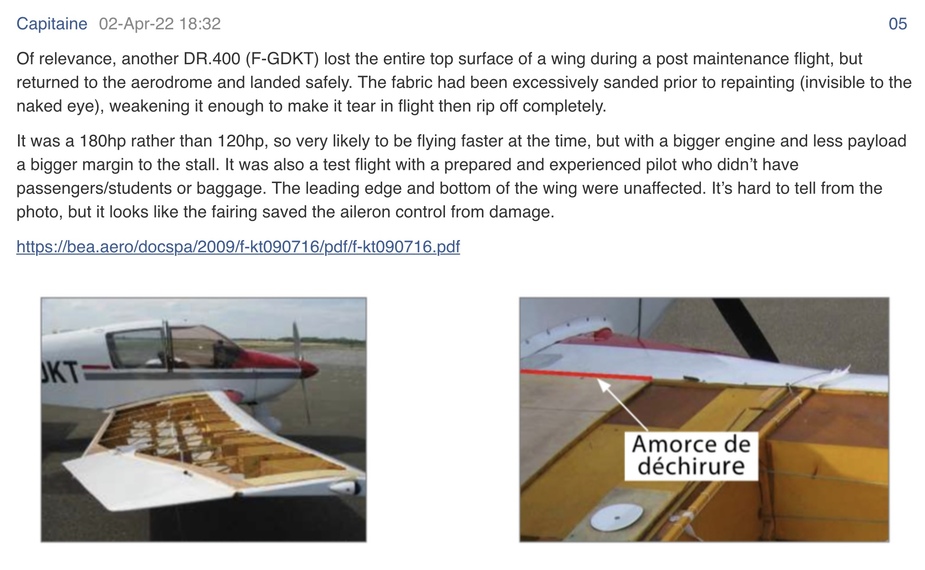That thread really got me worrying about the storks I often see at my homebase. Thankfully the energy of a collision on short final with 60 to 70 knots is much smaller than in cruise. Also the slower speed helps to see and avoid for both parties.
This post by Capitaine (BEA report here F-GDKT) raises question marks as to what really happened in this case.
Was the aircraft really uncontrollable, or did something else happen? Was the bird strike root cause, or causal factor? Guess we will never know…

I guess losing the top is not as dramatic as losing front or bottom?
The Steen SkyBolt had top of wing removed without structural failure after hitting a small bird but I guess bi-planes have wing redundancy…

There appears to be some confusing of incidents and reports in this thread and in the title of the other thread about bird strikes and wood and fabric aircraft and loss of control.
F-GNNE the report confirms a bird strike. The bird was still attached to the aircraft wreckage.
The bird did not hit the leading edge which is a curved plywood section. It is more likely that the bird hit behind this leading edge, in the area of the pitot tube and the landing light and probably just behind the landing light.
In the case of F-GDKT posted by Capitaine and then by Dan this was a case of maintenance done badly.
What is weird is that in the case of F-GDKT the whole of the upper skin, the extrados was lost yet it was landed safely.
Whereas in the case of F-GNNE the intrados skin was torn front to back.
So the question is why you could lose the whole of the upper skin and still maintain control, yet a tear in the lower skin plus the presence of an extra 2.4 kg attached to the wing could deform the wing enough to alter the drag and performance of the wing to lose all control with fatal consequences.
I have come across control problems in the past when attaching a film camera to the underside of a Cessna wing. The mount had been used before, but at the last minute the camera had to be switched from an Eclair or Aaton to and Arriflex. The take off was fine, so was the filming but a problem arose during the turns in descent.
The pilot was fighting what he described later as an oversteer problem which the engineers on the ground put down to the change of camera. The Arriflex being different in design.and weight. This was prior to the days of gyro pods.
Ibra wrote:
I guess losing the top is not as dramatic as losing front or bottom?
Most of the lift (2/3 IIRC) is generated at the top surface. E.g. a flexible wing is essentially only top surface. Not to mention sails.
gallois wrote:
So the question is why you could lose the whole of the upper skin and still maintain control, yet a tear in the lower skin plus the presence of an extra 2.4 kg attached to the wing could deform the wing enough to alter the drag and performance of the wing to lose all control with fatal consequences.
Yep, and this is why I presented the above. The weight of the bird’s carcass, 2.4kg, shouldn’t affect the handling by much. The top of the wing aerodynamics cannot be worse than when loosing the whole rag as in the case of F-GDKT. So, we are left with what happened to the bottom of the wing… the wing’s lifting and drag characteristics were affected no doubt, but by how much?
In short, I wonder if filming and taking pictures took precedence over flying… not much time when stalling at 1’500ft…
Sad.
A UK Jodel had the aged cotton fabric break off a complete wing bay. It landed safely.